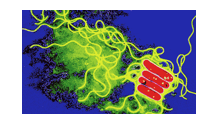Legionella Fact Sheet

Bellevue Hospital Center released the following factsheet to provide nurses with more information about Legionnaires' disease, including its risk factors, who should be tested, and diagnosis and treatment.
Legionella Fact Sheet
Each year, between 8,000 and 18,000 people are hospitalized with Legionnaires’ disease in the US. However, many infections are not diagnosed or reported, so this number may be higher. On July 29, 2015 the NYC Department of Health & Mental Hygiene (NYC DOHMH) issued an advisory concerning Legionnaires’ disease. Since July 8, 2015, the NYC DOHMH has been investigating an outbreak of Legionnaires’ Disease in the South Bronx. Currently there have been 71 cases of Legionella infection identified, including four related deaths, among people who live, work or visit this area. Five cooling towers in the outbreak zone have been identified as possible sources and have been remediated.
At Bellevue, we routinely conduct surveillance for Legionella by taking environmental water samples and random patient samples to screen for infection.
What is Legionnaires’ disease (Legionellosis)?
Legionnaires’ disease is caused by the bacteria Legionella and is characterized by pneumonia, occurring 2-10 days after exposure to an environmental source. Legionella is a ubiquitous aquatic organism that thrives in warm environments (32°- 45°C). More illness is usually found in the summer and early fall, but it can happen any time of year. How is Legionnaires’ disease transmitted and what are the symptoms? Exposure occurs through inhalation of contaminated aerosols from devices such as cooling towers, whirlpool spas, showers, and faucets, and through aspiration of contaminated water. Person to person transmission has NOT been demonstrated. Symptoms of Legionnaires’ disease are like many other forms of pneumonia and can include high fever, chills and a cough.
What are the risk factors for Legionnaires’ disease (Legionellosis)?
- Recent travel with an overnight stay outside the home
- Exposure to whirlpool spas
- Recent repairs or maintenance work on domestic plumbing
- Renal or hepatic failure
- Diabetes
- Systemic malignancy
- Smoking
- Immune system disorders
Who should be tested for Legionnaires’ disease?
- Hospitalized patients with enigmatic pneumonia
- Patients with enigmatic pneumonia sufficiently severe to require care in the ICU
- Immunocompromised hosts with pneumonia
- Patients with pneumonia in the setting of a legionellosis outbreak
- Patients who fail to respond to treatment to a ß-lactam or cephalosporin
- Patients with a travel history (traveled away from home within 2 weeks before the onset of illness)
- Patients suspected of nosocomial pneumonia with unknown etiology
What infection control precautions are necessary for patients with Legionnaires’ disease?
Standard precautions are sufficient when caring for patients with legionellosis. Hand hygiene must be performed before and after caring for the patient and appropriate personal protective equipment (PPE) such as gloves, gown, mask, and eye/face protection should be worn depending upon the task being performed.
How is Legionellosis diagnosed and treated?
Culture of Legionella from respiratory secretions or tissues is the gold standard diagnostic test. The best specimens for culturing Legionella are sputum or bronchoalveolar lavage fluid. Urine antigen testing is widely available as a rapid method for detecting L. pneumophila serogroup 1, which accounts for most community acquired Legionella cases. A negative urine antigen test, however, does not rule out infection from other Legionella species and serotypes, particularly among patients infected in the hospital. Serologic studies at baseline and at 4 weeks can also be used to establish diagnosis of Legionella infection, but often are not useful in the acute setting.
Antibiotic therapy: The macrolides, clarithromycin and azithromycin for 7-10 days or quinolones such as ciprofloxacin, levofloxicin or moxifloxicin for 10-14 days are the agents of choice for treatment of legionellosis. Rifampin may be a valuable adjunct but should not be used alone. Penicillins, cephalosporins, and the aminoglycosides are ineffective.
Recommendations from the NYC DOHMH
- Maintain a high index of suspicion for legionellosis among all patients with pneumonia, and specifically request both culture and urine antigen testing for legionellosis when indicated.
- Report suspect or confirmed cases to the NYC DOHMH.
- Send all positive cultures to the NYC DOHMH Public Health Laboratory for serotyping and molecular testing.
References: NYC DOHMH Advisory # 21, # 24: Increase in Legionnaires’ Disease in the Bronx, July 29, 2015; Aug 2, 2015 Legionnaires’ Disease Fact Sheets available at www.cdc.gov